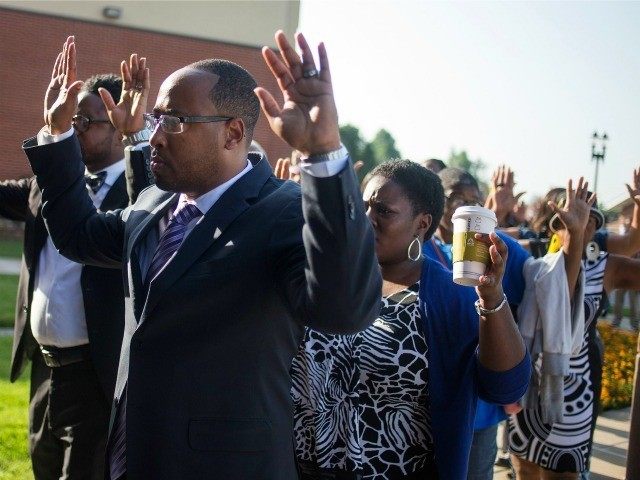According to an 86-page report issued by the Department of Justice, six of the most credible witnesses to the shooting of Michael Brown were afraid to give testimony in support of Ferguson, MO, police officer Darren Wilson, because they knew it would undercut the “Hands up, don’t shoot” narrative being advanced by their neighbors and, eventually, by the media.
Several expressed concern for their safety should they choose to contradict that narrative publicly. As one witness noted, there were signs in the neighborhood reading “snitches get stitches.”
The fear experienced by witnesses to the incident is a constant refrain in the DOJ report. Witness 102 (numbers are used to identify the witnesses rather than names) is described as a “27-year-old bi-racial male.” The report describes why witness 102 left the scene a few minutes after the shooting:
Witness 102 did not stay on Canfield Drive long after the shooting, but rather started to leave the area after about five minutes because he felt uncomfortable. According to Witness 102, crowds of people had begun to gather, wrongly claiming the police shot Brown for no reason and that he had his hands up in surrender. Two black women approached Witness 102, mobile phones set to record, asking him to recount what he had witnessed. Witness 102 responded that they would not like what he had to say. The women responded with racial slurs, calling him names like “white motherfucker.”
Witness 102 eventually presented himself to authorities because he was worried “witnesses would not come forward to tell the truth in this case because of community pressure.” The nature of that community pressure is made clear in the remainder of the report. Witness 103—a 58-year-old black male—”expressed concerns because there were signs in the neighborhood of Canfield Drive stating, “snitches get stitches.”
Witness 105 is a 50-year-old black woman who was driving a minivan down Canefield Drive at the time of the shooting. She later contacted the police but was hesitant to identify herself. She eventually agreed to meet detectives in a library parking lot. “She explained that she was coming forward because in speaking with her neighbors, she realized that what they believed had happened was inconsistent with what actually happened.”
Witness 108 is a 74-year-old black man. He told a detective he had seen the shooting and that officer Wilson was “in the right.” However Witness 108 refused to identify himself or give a formal interview out of “fear of reprisal should the Canfield Drive neighborhood find out that his account corroborated Wilson.” Witness 108 was tracked down two times by investigators after the initial canvass of witnesses. On both occasions he refused to give a formal interview. On the second occasion, he cited, “community sentiment to support a ‘hands up’ surrender narrative as his reason to remain silent.” He was subpoenaed but said he would go to jail before he would testify in support of officer Wilson.
Witness 109 followed the same course as Witness 108. He claimed the shooting was justified and left a long phone message saying that Michael Brown’s friend (Witness 101 in the report) had lied on national television. Even after he was subpoenaed, Witness 109 refused to testify.
Witness 113, a 31-year-old black woman, went even farther in her attempts to avoid having to testify. When a subpoena was sent to her house, she “blockaded her door with a couch.” When Witness 113 was interviewed by the FBI, she initially claimed officer Wilson had fired shots into Brown’s back as he lay on the ground. When the FBI agents pointed out that this was contradictory to the physical evidence of three separate autopsies, she changed her story to one that corroborated officer Wilson’s account. The report says, “She explained to the FBI that, ‘You’ve gotta live the life to know it,’ and stated that she feared offering an account contrary to the narrative reported by the media that Brown held his hands up in surrender.”
In all, six of the most credible witnesses to the shooting (those whose testimony was consistent with the physical evidence) were afraid of what neighbors would think or do if they found out they had given testimony which contradicted the narrative which took hold after the shooting.

COMMENTS
Please let us know if you're having issues with commenting.